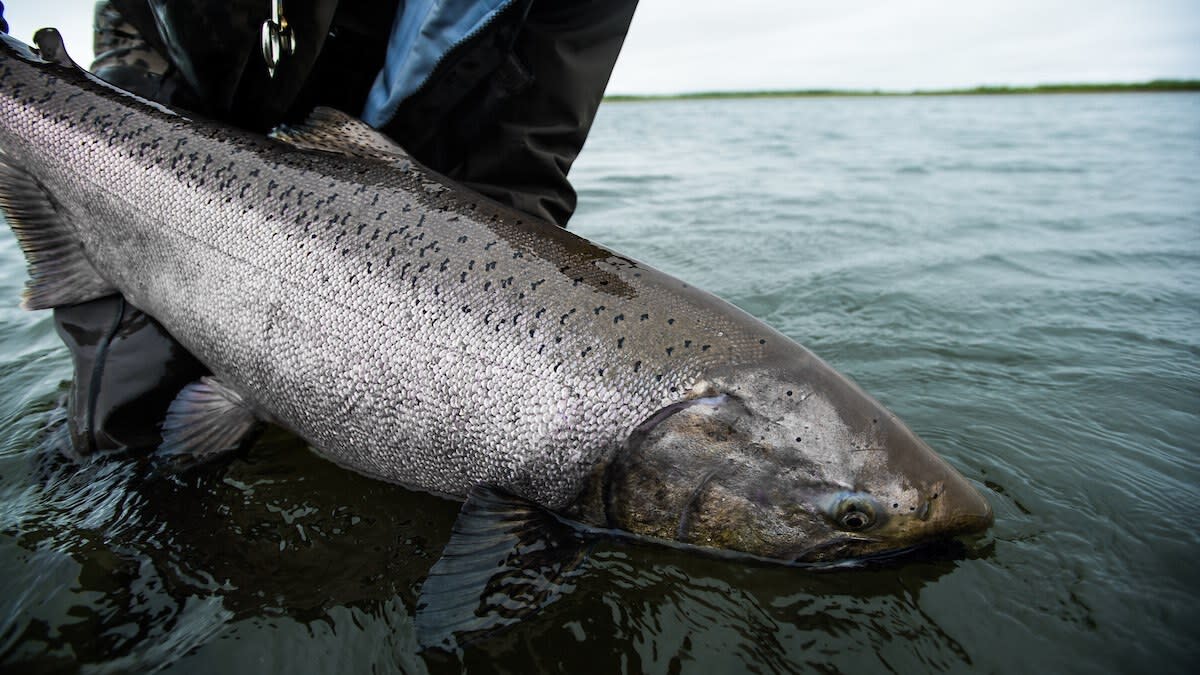
Twenty commercial salmon fishermens' heads turned in unison away from the beach bonfire toward the loud splash like so many dogs hearing a squirrel. The tide had risen steadily up the adjacent creek mouth as we reveled under the midnight sun, and something big had just jumped.
“Was that a seal?” Podge asked.
“I saw it flash red,” Michael responded.
My 8-weight was still strung and leaning against the truck from harassing Dolly Varden earlier. I strolled over, hauled line, and launched a gaudy pink streamer across the outflow. I stripped it back in without interruption. The next cast I let sink a little longer before pulsing the fly. The line came tight in my hand then ripped free. The small crowd of seiner crewmen and women heard my drag shriek and began wandering over to watch the show.
Heavy is the Head that Wears the Crown Of the six species of salmon present in the Pacific Ocean (Chinook/king, coho/silver, dog/chum, sockeye/red, pink/humpback, masu/cherry), Oncorhynchus tshawytscha grows largest by several magnitudes. While chum and coho have been recorded into the mid-30-pound range, that size barely turns heads in many prominent Chinook fisheries. The current Chinook IGFA rod-and-reel record rests at 97 pounds, but fish breaking the 100-pound mark have emerged from commercial gear as well.
Named for the Chinookan Tribe that traditionally resided near the mouth of the Columbia River, these important food fish are native along the Pacific Coast from Southern California and beyond the Arctic Circle in Alaska, as well as coastal areas of the Russia Far East and Japan’s northern islands. They penetrate deep into the interior of North American via massive rivers like the Yukon and Snake, reaching over a thousand miles into Central Idaho and the Yukon Territory. Chinook once spawned all the way into Nevada before construction of the Hell’s Canyon Dams. They have also been successfully introduced in New Zealand, Chile, the Great Lakes, and many other large waterbodies in the U.S. and Canada.
As anadromous salmonids, Chinook are born in the gravel of freshwater rivers and creeks where they mature for a year or more before travelling downstream to the ocean (or a pseudo-ocean like Lake Superior). With the abundance of marine nutrients, they grow large and travel thousands of miles through the North Pacific for one to eight years before (usually) returning the river in which they were born. Re-entering freshwater, king salmon’s appearance shifts from their pelagic purple-silver hue to darker red or brown color, their jaws lengthen, and teeth express. Like all Pacific salmon, they die after spawning, recycling their bodies to nourish the freshwater stream and their progeny growing up in it.
How to Catch Chinook in Saltwater and Big Lakes Kings are somewhat less school-oriented than their close cousins, but certain stocks do seem to arrive together at relatively predictable times. Many major rivers have more than one run of kings, often including springers, summers, and fall fish. Native tribes built their calendars around these rhythms.
Several areas, such as Alaska’s Kodiak Island and Washington and British Columbia’s Salish Sea, historically enjoyed nearly year-round Chinook seasons by pursuing winter “blackmouth” or immature Chinook of five to 25 pounds, a smaller portion of the population that remains resident to these waters instead of journeying out to the North Pacific. Blackmouth fisheries are still popular due to the aggressive nature of these fish, but the seasons are increasingly shortened due to conservation concerns.
Being in the right place at the right time is critical with open water Chinook. Luckily, however, that timing and location is rarely a secret since these fish attract so much attention, both for their sporting and eating qualities. You should be able to ascertain the run timing of a given area from local tackle shops, newspapers, or just by observing the mob of boats heading out.
As they come out of the open ocean and into nearshore bays, sounds, and river deltas, kings can be anywhere in the water column but they’re usually near the bottom, with variation depending on the spot, availability of bait, and stage of migration. Successful salmon anglers usually target points, humps, and shelves where kings most often will hold to encounter bait like squid, herring, anchovies, and candlefish. They’ll sometimes push those baitfish into a frenzy ball and follow it up to mid-water, the shore, or even the surface—often indicated by diving birds. But, for the sake of introduction, kings will be on or near the bottom unless your sonar says otherwise. Good electronics and the knowledge to use them can make or break saltwater salmon fishing.
Still, there is a general pattern worth noting: Pacific Ocean Chinook are typically suspended in the water column chasing herring and anchovy schools over depths ranging from 300-feet-plus miles offshore to 50 feet or less just outside kelp beds and breaking waves in iconic places like Southeast Alaska, Nootka Sound, B.C., and Cape Flattery, Washington.
As spring turns to summer and Chinook begin to nose inland, they’re often found feeding on sandlance (candlefish) tight to underwater banks and eel grass flats. In these situations, bouncing smaller spoons, baits, or jigs off the bottom in 80 to 150 feet of water can be exceptionally effective. Similar techniques work consistently for blackmouth.
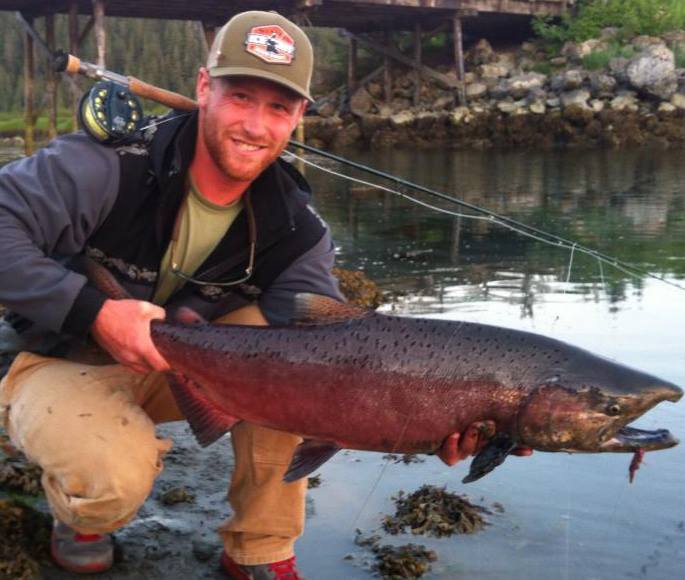 The author with a Chinook on the fly.
The author with a Chinook on the fly.
Later in summer, Chinook will start to stage in anticipation of fall rains, suspending in the water column again and feeding intermittently on clouds of larger herring and squid. This is where hoochies, plugs, Superbaits, and larger, gaudier presentations shine. Although weather, tide, and light conditions can have a big impact on the bite—especially closer to estuaries like the Columbia River mouth and Sacramento Bay—as these salmon now have spawning on the brain.
Trolling Far and away the most common and productive way to catch Chinook is by dragging gear behind a moving boat, often employing downriggers to get your tackle down 100 feet or more to where they’re hanging. Downriggers are like a separate, very heavy-duty rod and reel attached to the stern of the vessel and strung with cable and a large lead weight, often 10 or 15 pounds, which you attach with a release clip to the line of your normal rod and reel. The angler then descends all the gear in tandem toward the bottom. When a fish strikes, the line pulls free from the release clip and you can fight the fish and bring in the downrigger ball separately. Some anglers use other diving mechanisms to get their troll gear down, such as Dipsy Divers, deep-diving plugs, or just a lot of in-line weight.
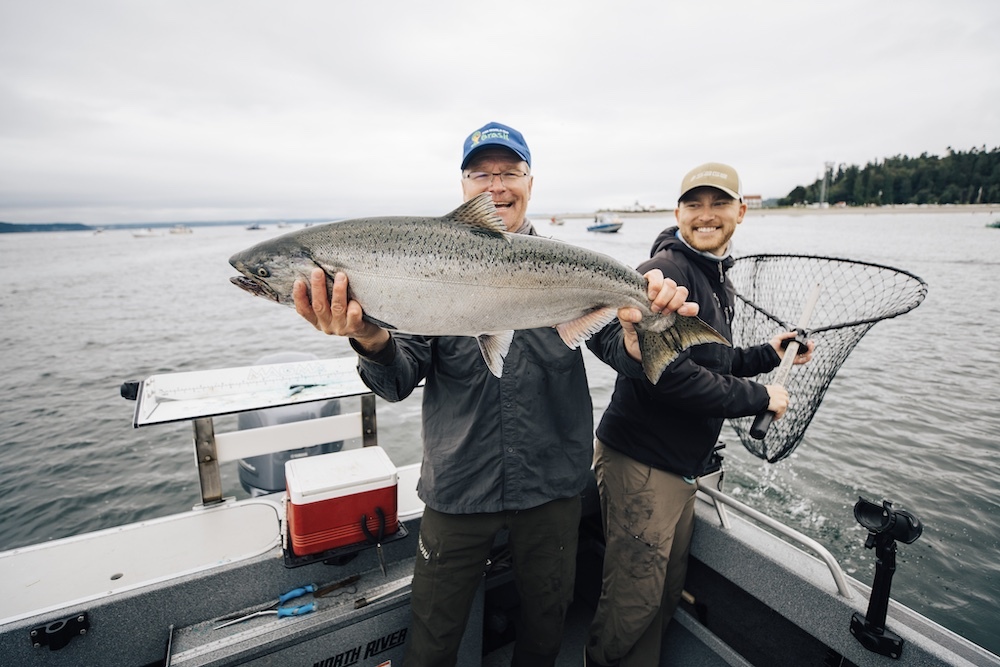 Trolling for Chinook. Image via Chase Gunnell.
Trolling for Chinook. Image via Chase Gunnell.
“If I had to pick two depths where I consistently set my downriggers to the start the day, it would be one at 90 feet and the other around 120, or right above the bottom,” said Chase Gunnell, a lifelong salmon angler and spokesman for Conservation Northwest who keeps a boat on Puget Sound. “From Neah Bay to Seattle and Southeast Alaska, those numbers work for me. I tend to run a spoon on the deep rod on a longer leader, with a hoochie squid or Ace Hi trolling fly on the shallower rod, switching both to whatever gear and depth is working once the bite turns on.”
Flashers and dodgers, oblong 8- to 16-inch pieces of flashy plastic or metal respectively, are common components of trolling rigs for kings. They throw off a lot of flash and vibration that attracts salmon and provides a lot of action to your terminal gear.
There’s an almost-endless array of terminal lures and baits that have and will catch kings. Where I’m from in western Washington the standards are Hoochie Squid, Kingfisher or Coyote spoons that imitate herring; Coho Killer or Wee Gee spoons that look like candlefish; or plug-cut herring. I’ve also seen wiggling plugs, spinners, and a variety of different bait-holding mechanisms employed in the Great Lakes and Alaska. Popular colors include green, chartreuse, black, white, orange, and pink. It’s really a matter of experimentation and personal preference. The most popular color of all is “Herring Aid,” a mix of black, blue, and chartreuse offered by a number of tackle makers. Kings are not often exceptionally picky while they’re chowing down in preparation for the long run up the river.
Jigging and Mooching My father reached a point recently where he’d untangled enough downrigger cables braided into monofilament from wild tidal currents or sharp turns. He swore off downrigger fishing and now intends to only target kings with a straight line to a lure or bait. Can’t say I blame him.
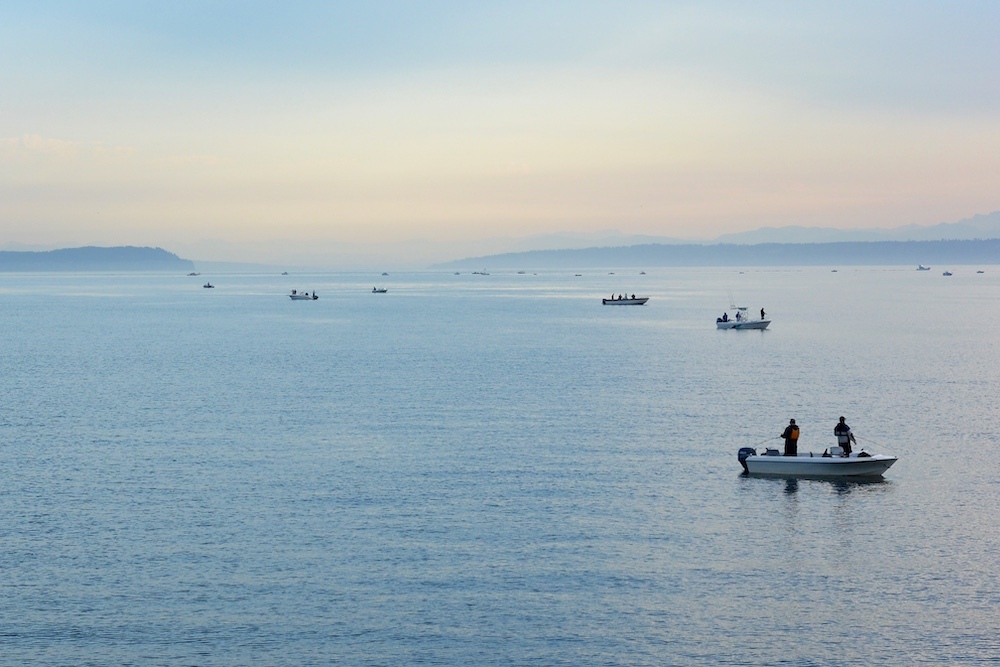 Mooching for Chinook. Image via Chase Gunnell.
Mooching for Chinook. Image via Chase Gunnell.
One of the oldest and most effective methods for Chinook is what’s known as “mooching.” You’d be excused for not hearing of it until now. It involves dropping a big banana sinker to the bottom with a leader of 4 to 8 feet to double hooks rigged with a whole or plug-cut herring or other local baitfish. Anglers then drift on the current through likely areas around humps, rockpiles, and points. Simple but deadly.
Similarly, jigging just like you might do for walleye or lake trout can be very productive for Chinook. The gold standard in my mind is the venerable Point Wilson Dart, but my partiality may derive from the fact that I grew up fishing in the lee of Point Wilson itself. Crippled Herring, Buzz Bombs, Butterfly jigs, and even bucktails can do damage where the current is slow enough to get them to the bottom. A 20-pound king smashing a jig like a freight train is inarguably more exhilarating than seeing a downrigger rod pop up in the holder.
“Mooching is my absolute favorite way to fish for Chinook,” Gunnell said. “There’s something so special about fishing the same way that my dad, grandfather and great grandfather did, no downriggers, flashers or complicated gear, just weight and bait. And once you learn where and when to fish, mooching can be just as effective as more modern techniques.”
Gunnell said that an important element to keep in mind is that mooching is best with a little line angle while drifting in the current or wind, holding with your motor. You need to let the fish chew on the bait before coming tight, he says.
“Vertical jigging on the other hand should be done with as little angle as possible, keeping your line nearly straight so you can feel the take and set the hook,” he said. “The bite will almost always come as the jig flutters on the drop, and you need be ready.”
How to Catch Chinook in Rivers and Deltas For those without a seaworthy vessel or just hoping to use the natural advantage of a bottleneck, streams and their mouths are excellent places to intercept migrating salmon.
Like most salmon, however, Chinook stop actively feeding once they go through the metamorphosis required to transition back into living and breathing in freshwater. They may remain hungry and grabby in the estuary or lower tidal reaches of a stream, but often become increasingly difficult to tempt the further upstream they travel. That is by no means to say that they won’t absolutely annihilate a fly or spinner, just that such a take is more likely out of aggression or territorialism than actual food consumption.
Chinook are big, bulky fish, which is all the more evident once they’re in smaller waters. While they will travel up shallower inside bends, they’ll often hole up in the deepest spots in a river—plunge pools, log jams, deep back eddies. They’ll aggregate in these “salmon holes,” which you can often identify with relative ease because kings love to jump and roll on the surface every now and then. There are a million ways to catch them, but I’ll try to break down the basics.
Lure Fishing I wouldn’t be at all surprised to know that the Blue Fox Vibrax Spinner is the leading cause of untimely death for king salmon in the state of Alaska. The slow thump and pulse of a spinning piece of metal is as deadly an attractant as any. Numerous other spinners work well, as do large spoons like B.C. Steel or RVRFSHR. You can swing such hardware down and across the current or work it slowly across stagnant eddies where kings pile up. The rule of thumb is to work these lures as deep and slow as possible, only fast enough to make the blade turn over.
“Chinook seem especially partial to purple, blue, and brass-colored spinners, though black and green can be effective fallbacks as the sun gets higher or water gets slower and clearer,” Gunnell said.
Boats are advantageous for accessing kings in rivers, and certain techniques rely on a floating device. In larger, lower rivers the same trolling and jigging techniques discussed above can be useful. Many anglers like to back-troll diving plugs like Hotshots, Kwikfish, and Flatfish both in tidewater and higher in river basins. This technique is performed by running the plugs off the bow of drift boat or raft (or stern of a jet boat) and rowing or motoring against the current while slowly backing the plugs down through likely holding water. These plugs are often dressed with a strip of herring or scent to draw in salmon.
One other method that has grown popular in recent years is twitching jigs for kings. Much like bass fishing with plastics, you cast a jig head with a hoochie skirt or twister tail threaded on the hook shank and slowly twitch or hop it back along the bottom. This can produce strikes from even the most lock-jawed Chinook.
Bait Fishing Kings are very scent-oriented and there may be nothing they like more than cured salmon eggs. I’ve heard it postulated that eating eggs may be an adaptation to reduce genetic competition, but it could just be a simple snack for extra calories on their upstream swim. Cured and colored shrimp are a close second in popularity, providing a much more durable and castable attractant than eggs.
Salmon eggs can be cured, contained, and presented in a myriad of ways. Some folks use Borax, some use salt, some use red Jell-O. Some wrap them in thin mesh spawn sacks while others trim egg skeins into quarter-sized chunks. You can deliver your eggs to the fish based on the situation—suspended under a slip float through slower water, side-drifting through heavy current behind a stick of pencil lead, or free-lined weightless in finesse situations. Back-bouncing on the bottom with a lot of weight as a driftboat works through deep pockets can seduce hunkered-down kings.
Among the more relaxing and efficient styles of bait fishing for them involves using a big pyramid sinker with a leader to a spin-n-glo and double snell rig with a gob of worms. You cast the rig, get the weight to settle in a likely travelling lane, post the rod in a shore spike holder or forked stick, sit back, and wait. It’s called “plunking” and it’s equal parts redneck and refined.
Fly Fishing Where you can get close enough and deep enough to lay a fly before the king, it works almost as well as any other method. There’s something about the pulse and wiggle of marabou, rabbit fur, and other natural materials that must evoke squid, shrimp, or other oceanic forage. Likely the most popular fly angling tactic is swinging across the current with a heavy Spey rod and a large, bulky fly like an Intruder. But certain situations can dictate the need for nymphing egg patterns through deep runs or stripping streamers through slow or tidal waters for more active fish. A one-to-one gear ratio fly reel may be the best way to experience the sheer strength of the world’s largest salmonid.
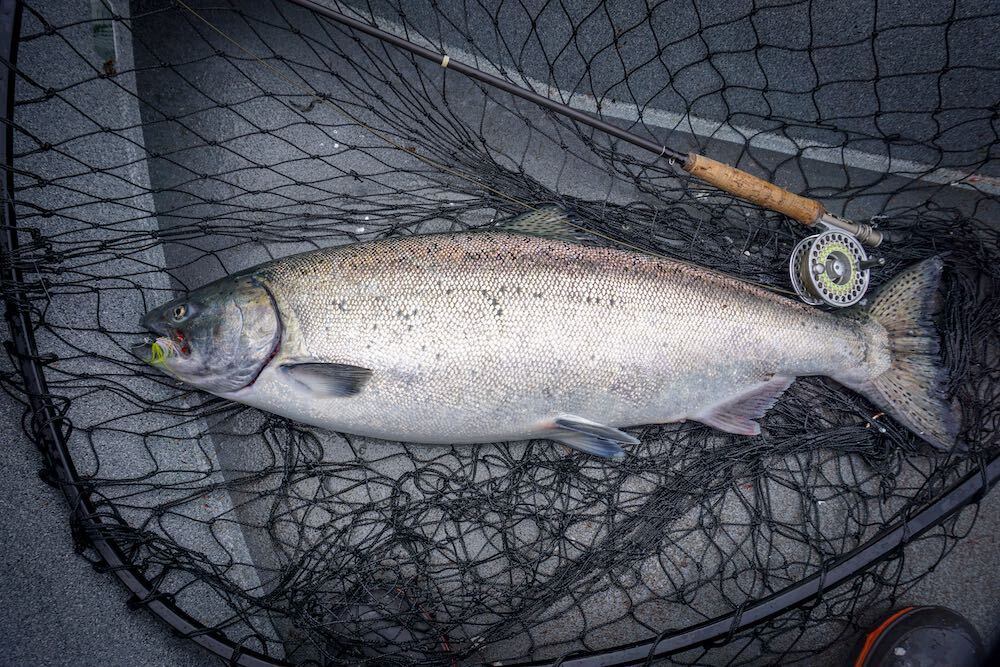 Chinook on the fly. Image via Chase Gunnell.
Chinook on the fly. Image via Chase Gunnell.
Long Live the King Chinook salmon are experiencing long-term decline throughout much of their native range. Dams, culverts, deforestation, overfishing, increased predator abundance, hatcheries, fish farms, adverse ocean conditions, climate change, and countless other factors may play roles in individual stock health. New distinct populations segments are proposed for Endangered Species Act listing in the U.S. every year. But there are bright spots and annual fluctuations, so it’s incumbent on each individual angler to not only know the regulations and restrictions but carry a measure of stewardship with them to the king water every day of the run. Chinook taste better than almost any other meat on Earth, yet it’s often more satisfying to release a wild fish to bring on the next generation than to put it in the cooler.
“Chinook are undoubtedly the most iconic fish across the Pacific Northwest and Alaska, but these days we can’t take them for granted,” Gunnell said. “Anglers and others passionate about these fish should get involved with conservation groups working on their behalf, especially efforts to recover freshwater spawning areas through on-the-ground restoration projects and policies to responsibly limit development in salmon habitat; as habitat loss is the biggest barrier to West Coast salmon recovery today.”
As my commercial fishing friends filtered from the bonfire to the beach that summer night outside Cordova, we all soon acknowledged that it must be a Chinook at the end of my ever-extending line reaching from the backing out into the bay. Nothing else fights like that. Eventually, worn under the strain of dragging so much thick fly line through the floating eel grass and saltwater, the fish began to pendulum swing back toward shore as I diligently cranked on the underpowered reel and rod. After nearly a half-hour we trapped the fish in the shallows, hoisted it for a photo, and sent it on its royal way. It’s always an honor to be graced by the king’s presence.
Feature image via Tosh Brown




